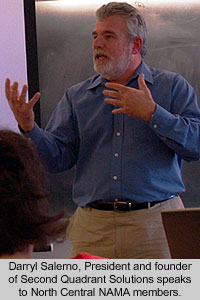
Nearly 200 attendees participated in the 2006 Agribusiness Forum that was held November 14-15 in Kansas City. This year’s Forum took place just prior to the NAFB Convention and featured industry experts from inside and outside the agricultural community. Individual speakers and panels explored topics such as the global forces shaping agriculture, biofuels, and branding.
Ann Ness, Vice President of Corporate Brand Management at Cargill, presented Repositioning the Masterbrand: The Cargill Case Study at the Forum.
Cargill is a family owned company that began as a grain elevator and has grown to 152,000 employees in 69 countries and more than 80 businesses. In 1999, Cargill made a change in their business model and launched a new identity in 4 steps over 6 years. The first step was the creation of a brand council to develop a corporate vision statement, a purpose and vision, how to approach it and to measure the performance.
Next was the brand architecture. Cargill wanted to operate as a master brand and not as a holding company. Their goal is to be the global leader by 2010.
Cargill then developed brand positioning with the help of a brand strategy firm. This firm made Cargill talk to their customers who said they do not think of Cargill as an innovator or as collaborative, but strictly as a commodities provider; but said they viewed Cargill as very smart. This research led to the creation of brand positioning. The final step was advertising strategy that focused on providing evidence of relationships through television commercials.
So, is this working to reposition the Cargill brand? Cargill measures attitude and awareness every year and what they are finding is that perceptions are broadening and improving. “We are very encouraged by results,” said Ness. Cargill has been able to measure farmer responses with focus groups around the world.
Cargill also had to change internally. They had to refocus, “changes had to be made internally in order to deliver externally. Part of Cargill’s success is their entrepreneurial spirit,” said Ness.
For more information on the Forum sessions and interviews with the speakers, visit the Forum blog written by Chuck Zimmerman, AgWired.com, in the NAMA News.

 “The goal of negotiating is to build and sustain relationships,” Darryl Salerno, President and founder of Second Quadrant Solutions, told North Central NAMA members attending the October 19 negotiating workshop held on the University of Minnesota-St. Paul campus. Second Quadrant Solutions, a New York-based consultant group, provides executive coaching and professional development training for service organizations.
“The goal of negotiating is to build and sustain relationships,” Darryl Salerno, President and founder of Second Quadrant Solutions, told North Central NAMA members attending the October 19 negotiating workshop held on the University of Minnesota-St. Paul campus. Second Quadrant Solutions, a New York-based consultant group, provides executive coaching and professional development training for service organizations. Several members of the Carolinas/Virginia NAMA Chapter gathered together on October 17 in Mount Airy, North Carolina for a tour of
Several members of the Carolinas/Virginia NAMA Chapter gathered together on October 17 in Mount Airy, North Carolina for a tour of  that provides higher returns than production agriculture. A portion of the flour used by Gerard’s is made from identity-preserved wheat supplied by its members. Headquartered in Longmont, Colorado, Gerard’s sells unique breads and rolls to restaurant chains and food service sections of grocery and convenience store chains.
that provides higher returns than production agriculture. A portion of the flour used by Gerard’s is made from identity-preserved wheat supplied by its members. Headquartered in Longmont, Colorado, Gerard’s sells unique breads and rolls to restaurant chains and food service sections of grocery and convenience store chains.  The last presentation at the Agribusiness Forum yesterday was given by Sano Shimoda, BioScience Securities.
The last presentation at the Agribusiness Forum yesterday was given by Sano Shimoda, BioScience Securities.
 One of the presenters this afternoon was Hugh Whaley, Osborn & Barr Communications.
One of the presenters this afternoon was Hugh Whaley, Osborn & Barr Communications.